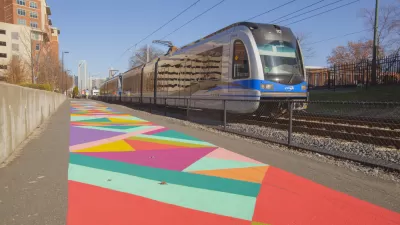Charlotte's light rail system has proven to be a major success in the city, spurring development and igniting the local economy. But as it expands, will the other communities it benefits join in the funding party?
"Back when urban junkies - myself included - dreamed that cities could center around train lines, we railed at the formula-oriented developers who could crank out only cul-de-sacs and subdivisions near the newest highway off-ramp. They ignored the possibility of putting apartment buildings and mixed-used projects beside a trolley line, even if a city could manage to get a rail line built."
"No longer. Now big international companies such as Cherokee Investment Partners, which is involved here in Charlotte, are poised - even eager - to swoop down, buy land and put up pedestrian-friendly businesses and homes around new transit stations. And they're being joined by plenty of competitors."
"Charlotte opened its $465 million, 15-stop, 10-mile "blue line" last November. LYNX, as it is called, has about 13,000 riders daily, well ahead of the low-ball federal projections. Now, the city and region are working on the many other ideas for lines and extensions. A total of 7,000 new condominiums are planned along the line."
"Seeing how successful Charlotte's new line is, I start believing what I first dismissed as hyperbole - that it was revolutionary."
FULL STORY: More than Just a Train

Maui's Vacation Rental Debate Turns Ugly
Verbal attacks, misinformation campaigns and fistfights plague a high-stakes debate to convert thousands of vacation rentals into long-term housing.

Planetizen Federal Action Tracker
A weekly monitor of how Trump’s orders and actions are impacting planners and planning in America.

Chicago’s Ghost Rails
Just beneath the surface of the modern city lie the remnants of its expansive early 20th-century streetcar system.

Bend, Oregon Zoning Reforms Prioritize Small-Scale Housing
The city altered its zoning code to allow multi-family housing and eliminated parking mandates citywide.

Amtrak Cutting Jobs, Funding to High-Speed Rail
The agency plans to cut 10 percent of its workforce and has confirmed it will not fund new high-speed rail projects.

LA Denies Basic Services to Unhoused Residents
The city has repeatedly failed to respond to requests for trash pickup at encampment sites, and eliminated a program that provided mobile showers and toilets.
Urban Design for Planners 1: Software Tools
This six-course series explores essential urban design concepts using open source software and equips planners with the tools they need to participate fully in the urban design process.
Planning for Universal Design
Learn the tools for implementing Universal Design in planning regulations.
planning NEXT
Appalachian Highlands Housing Partners
Mpact (founded as Rail~Volution)
City of Camden Redevelopment Agency
City of Astoria
City of Portland
City of Laramie




























